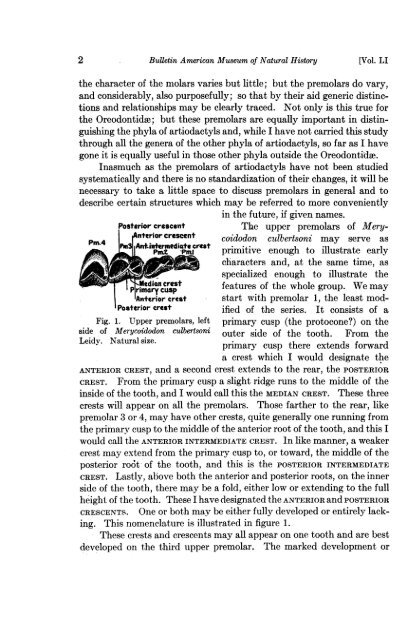View/Open - American Museum of Natural History
View/Open - American Museum of Natural History
View/Open - American Museum of Natural History
Create successful ePaper yourself
Turn your PDF publications into a flip-book with our unique Google optimized e-Paper software.
2 Bulletin <strong>American</strong> <strong>Museum</strong> <strong>of</strong> <strong>Natural</strong> <strong>History</strong><br />
[Vol. LI<br />
the character <strong>of</strong> the molars varies but little; but the premolars do vary,<br />
and considerably, also purposefully; so that by their aid generic distinctions<br />
and relationships may be clearly traced. Not only is this true for<br />
the Oreodontidae; but these premolars are equally important in distinguishing<br />
the phyla <strong>of</strong> artiodactyls and, while I have not carried this study<br />
through all the genera <strong>of</strong> the other phyla <strong>of</strong> artiodactyls, so far as I have<br />
gone it is equally useful in those other phyla outside the Oreodontidae.<br />
Inasmuch as the premolars <strong>of</strong> artiodactyls have not been studied<br />
systematically and there is no standardization <strong>of</strong> their changes, it will be<br />
necessary to take a little space to discuss premolars in general and to<br />
describe certain structures which mav be referred to more conveniently<br />
in the future, if given names.<br />
Posterior crescent The upper premolars <strong>of</strong> Mery-<br />
Anterior crescent coidodon culbertsoni may serve as<br />
Pm4 3PO Ant.intermedicte crest<br />
PM± VpW primitive enough to illustrate early<br />
characters and, at the same time, as<br />
crest<br />
Medincrest<br />
specialized enough to illuistrate the<br />
features <strong>of</strong> the whole group. We may<br />
Anferior crest start with premolar 1, the least mod-<br />
Posterior crest ified <strong>of</strong> the series. It consists <strong>of</strong> a<br />
Fig. 1. Upper premolars, left primary cusp (the protocone?) on the<br />
side <strong>of</strong> Merycoidodon culbertsoni outer side <strong>of</strong> the tooth. From the<br />
]Leidy. <strong>Natural</strong> size. primary cusp there extends forward<br />
a crest which I would designate the<br />
ANTERIOR CREST, and a second crest extends to the rear, the POSTERIOR<br />
CREST. From the primary cusp a slight ridge runs to the middle <strong>of</strong> the<br />
inside <strong>of</strong> the tooth, and I would call this the MEDIAN CREST. These three<br />
crests will appear on all the premolars. Those farther to the rear, like<br />
prenmolar 3 or 4, may have other crests, quite generally one running from<br />
the primary cusp to the middle <strong>of</strong> the anterior root <strong>of</strong> the tooth, and this I<br />
would call tile ANTERIOR INTERMEDIATE CREST. In like manner, a weaker<br />
crest may extend from the primary cusp to, or toward, the middle <strong>of</strong> the<br />
posterior root <strong>of</strong> the tooth, and this is the POSTERIOR INTERMEDIATE<br />
CREST. Lastly, above both the anterior and posterior roots, on the inner<br />
side <strong>of</strong> the tooth, there may be a fold, either low or extending to the full<br />
height <strong>of</strong> the tooth. These I have designated the ANTERIOR and POSTERIOR<br />
CRESCENTS. One or both may be either fully developed or entirely lacking.<br />
This nomenclature is illustrated in figure 1.<br />
These crests and crescents may all appear on one tooth and are best<br />
developed on the third upper premolar. The marked development or

















